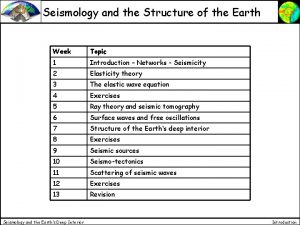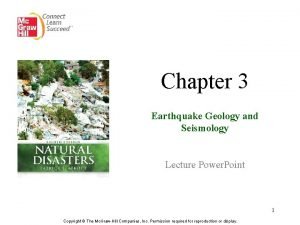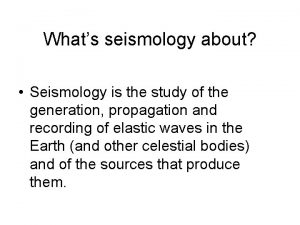1 Lecture4 CE312 Engineering Geology and Seismology Instructor













- Slides: 13

1

Lecture#4 CE-312 Engineering Geology and Seismology Instructor: Dr Amjad Naseer Department of Civil Engineering University of Engineering and Technology, Peshawar 2

Outlines of the Presentation 1. Geological Cycle: Rock formation 2. Types of Rocks 3

The Geological Cycle: Rock formation Geological cycle includes many processes acting simultaneously. The most important of these begin with molten magma from within the earth forming into rock, then continues with rocks being broken down into soil, and that soil being converted back into rock. 4

The Geological Cycle: Rock formation Rocks are classified according to their place in the geologic cycle. The three major categories are 1. Igneous, 2. Sedimentary and 3. Metamorphic 5

Types of Rocks Igneous Rock: The geologic cycle begins with magma, a molten rock deep inside the earth. This magma cools as it moves upward toward the ground surface, forming igneous rocks. 6

Types of Rocks Classification of Igneous Rock: On the basis texture (size, shape and arrangement of mineral grains in a rock) and mode of occurance, Igneous rock is divided broadly into two types: 1. Intrusive (also called plutonic rocks): form below the ground surface, where they cool slowly, 2. Extrusive (also called volcanic rocks) arrive at the ground surface in a molten state, such as through volcanic eruption. This type of igneous rock cools very rapidly. 7

Igneous Rocks Hypabyssal Rock: Hypabyssal rocks are formed when consolidation of magma takes place very close to the earth’s surface in the form of smaller sheet like bodies (known as sills and dykes) that fill cracks inside other rocks. Some extrusive generally have finer grained, smoother surfaces. Some extrusive materials, such as volcanic ash, bypasses the rock stage and forms directly into sediment 8

Common Igneous Rocks Some common igneous rocks include: Granite: is coarse grained, an intrusive rock. It is the most common and familiar igneous rocks. Granite contains primarily orthoclase feldspar and quartz, with some biotite and amphibole. It is mostly light in color with a white or pink tint according to the color of the feldspar. Engineering properties: Granite have absorption as low as 0. 24 per cent. It has an excellent frost resistance. Because of the minerals composition and interlocking of crystals, granite is hard and abrasion resistant. The compressive strength of granite is on average 24, 500 psi. Granite can be used to support any load of ordinary structures. Granite is also used as tiles for flooring in buildings. 9

Common Igneous Rocks Diorite: is coarse grained, an intrusive rock. It is mainly composed of plagioclase feldspar (more than 50 %) and hornblends. However, in some varieties augite and biotite may be present. It is more abundant than syenites but less abundant than granite. Diorite has been used for crushed stone for monumental and decorative purposes than for structural purposes. Syenite: is grained igneous rocks composed essentially of potassium felspare (80 -85 %). Biotite and hornblende are commonly present. Quartz is present in small amount. The general properties of syenites is similar to granite. Because of the rarity of syenite, it is of little commercial use as structural material. 10

Common Igneous Rocks Some other types of igneous rocks are: • Rhyolite, Pumice (can be used as pozzolanic materials with cement), • Dolerite, • Basalt and • Gabbro. 11

Common Igneous Rocks Texture: Texture is size, shape and arrangement of mineral grains in a rock. Texture of rock can either of coarse-crystalline or it can be glassy or amorphous. The texture of the rock is governed by the cooling time of the magma. Crystallization is governed by slow cooling, however, glassy texture or amorphous form is the result of rapid cooling. Types of rock: Holocrystalline, Coarse grained, fine grained, cryptocrystalline and glassy (amorphous) 12

Dike and sill Sill: A sill is igneous rock which vary in thickness from a few centimeter to several hundred meters. The sill is parallel to the bedding of rock and may be horizontal, inclined or vertical depending upon the strata. Dike: A dike is vertical wall-like igneous body that cuts the bedding of the rock. The thickness of the dike may vary from a few centimeters to a hundred meter or more. 13

























